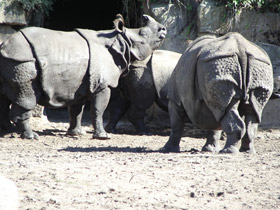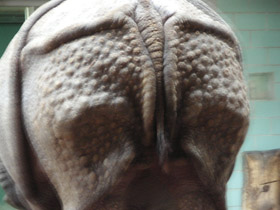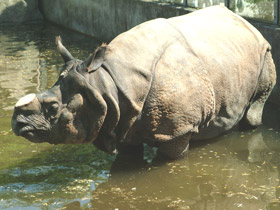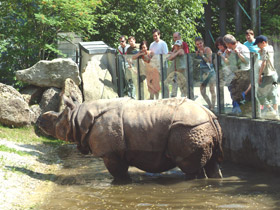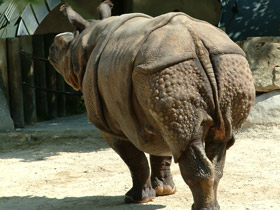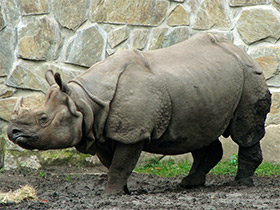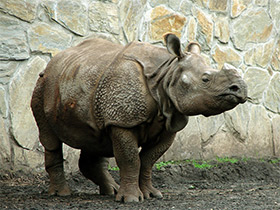The Indian rhinoceros or Indian rhino for short, the greater one-horned rhinoceros or great Indian rhinoceros (Rhinoceros unicornis)
The Indian rhinoceros or Indian rhino for short, the greater one-horned rhinoceros or great Indian rhinoceros (Rhinoceros unicornis) is included in the IUCN Red List as a vulnerable species.
The Indian rhinoceros (Rhinoceros unicornis), or Indian rhino for short, also known as the greater one-horned rhinoceros or great Indian rhinoceros, is a rhinoceros species native to the Indian subcontinent. It is listed as Vulnerable on the IUCN Red List, as populations are fragmented and restricted to less than 20,000 km2 (7,700 sq mi). Moreover, the extent and quality of the rhino's most important habitat, the alluvial Terai-Duar savanna and grasslands and riverine forest, is considered to be in decline due to human and livestock encroachment. As of August 2018, the global population was estimated to comprise 3,588 individuals, including 2,939 individuals in India and 649 in Nepal. Kaziranga National Park alone had an estimated population of 2,048 rhinos in 2009. Pobitora Wildlife Sanctuary in Assam has the highest density of Indian rhinos in the world with 84 individuals in an area of 38.80 km2 (14.98 sq mi) in 2009.
Indian rhinos once ranged throughout the entire stretch of the Indo-Gangetic Plain, but excessive hunting and agricultural development reduced its range drastically to 11 sites in northern India and southern Nepal. In the early 1990s, between 1,870 and 1,895 Indian rhinos were estimated to have been alive. Since then, numbers have increased due to conservation measures taken by the government. However, poaching remains a continuous threat, as more than 150 Indian rhinos were killed in Assam by poachers between 2000 and 2006.
Nearly 85% of the global Indian rhinoceros population is concentrated in Assam, where Kaziranga National Park contains 70% of rhino population.
Etymology
The generic name Rhinoceros is a combination of the ancient Greek words ῥίς (ris) meaning "nose" and κέρας (keras) meaning "horn of an animal". The Latin word ūnicornis means "one-horned".
Taxonomy
Rhinoceros unicornis was the scientific name used by Carl Linnaeus in 1758 who described a rhinoceros with one horn. As type locality, he indicated Africa and India.
The Indian rhinoceros is monotypic. Several specimens were described since the end of the 18th century under different scientific names, which are all considered synonyms of Rhinoceros unicornis today:
- Rhinoceros indicus by Cuvier, 1817;
- Rhinoceros asiaticus by Blumenbach, 1830;
- Rhinoceros stenocephalus by Gray, 1867;
- Rhinoceros jamrachi by Sclater, 1876;
- Rhinoceros bengalensis by Kourist, 1970.
Characteristics
Indian rhinos have a thick grey-brown skin with pinkish skin folds and one horn on their snout. Their upper legs and shoulders are covered in wart-like bumps. They have very little body hair, aside from eyelashes, ear fringes and tail brush. Bulls have huge neck folds. The skull is heavy with a basal length above 60 cm (24 in) and an occiput above 19 cm (7.5 in). The nasal horn is slightly back-curved with a base of about 18.5 cm (7.3 in) by 12 cm (4.7 in) that rapidly narrows until a smooth, even stem part begins about 55 mm (2.2 in) above base. In captive animals, the horn is frequently worn down to a thick knob.
The Indian rhino's single horn is present in both bulls and cows, but not on newborn calves. The horn is pure keratin, like human fingernails, and starts to show after about six years. In most adults, the horn reaches a length of about 25 cm (9.8 in), but has been recorded up to 57.2 cm (22.5 in) in length and 3.051 kg (6.73 lb) in weight.
Among terrestrial land mammals native to Asia, Indian rhinos are second in size only to the Asian elephant. They are also the second-largest living rhinoceros, behind only the white rhinoceros. Bulls have a head and body length of 368–380 cm (12.07–12.47 ft) with a shoulder height of 163–193 cm (5.35–6.33 ft), while cows have a head and body length of 310–340 cm (10.2–11.2 ft) and a shoulder height of 147–173 cm (4.82–5.68 ft). The bull, averaging about 2,070–2,200 kg (4,560–4,850 lb) is heavier than the cow, at an average of about 1,599–1,608 kg (3,525–3,545 lb).
The rich presence of blood vessels underneath the tissues in folds gives them the pinkish colour. The folds in the skin increase the surface area and help in regulating the body temperature. The thick skin does not protect against bloodsucking Tabanus flies, leeches and ticks.
The largest individuals reportedly weighed up to 4,000 kg (8,800 lb).
Distribution and habitat
Indian rhinos once ranged across the entire northern part of the Indian subcontinent, along the Indus, Ganges and Brahmaputra River basins, from Pakistan to the Indian-Myanmar border, including Bangladesh and the southern parts of Nepal and Bhutan. They may have also occurred in Myanmar, southern China and Indochina. They inhabit the alluvial grasslands of the Terai and the Brahmaputra basin. As a result of habitat destruction and climatic changes its range has gradually been reduced so that by the 19th century, it only survived in the Terai grasslands of southern Nepal, northern Uttar Pradesh, northern Bihar, northern West Bengal, and in the Brahmaputra Valley of Assam.
The species was present in northern Bihar and Oudh at least until 1770 as indicated in maps produced by Colonel Gentil. On the former abundance of the species, Thomas C. Jerdon wrote in 1867:
This huge rhinoceros is found in the Terai at the foot of the Himalayas, from Bhutan to Nepal. It is more common in the eastern portion of the Terai than the west, and is most abundant in Assam and the Bhutan Dooars. I have heard from sportsmen of its occurrence as far west as Rohilcund, but it is certainly rare there now, and indeed along the greater part of the Nepal Terai; ... Jelpigoree, a small military station near the Teesta River, was a favourite locality whence to hunt the Rhinoceros and it was from that station Captain Fortescue ... got his skulls, which were ... the first that Mr. Blyth had seen of this species, ...
Today, its range has further shrunk to a few pockets in southern Nepal, northern West Bengal, and the Brahmaputra Valley. Its habitat is surrounded by human-dominated landscapes, so that in many areas, it occurs in cultivated areas, pastures, and secondary forests. In the 1980s, Indian rhinos were frequently seen in the narrow plain area of Manas River and Royal Manas National Park in Bhutan.
Populations
In 2022, the total Indian rhinoceros population was estimated to 4014, up from 2,577 in 2006. Among them 3262 are in India and the remaining 752 are in Nepal and Bhutan. There is not permanent rhino population in Bhutan, but small rhino populations are occasionally known to cross from the Manas National Park or Buxa Tiger Reserve in India. The distribution of rhino in India is as follows:
- 2,885 individuals in Assam, including 2,613 in Kaziranga National Park, 125 in Orang National Park, 107 in Pobitora Wildlife Sanctuary and 40 in Manas National Park.
- 339 individuals in West Bengal, including 287 in Jaldapara National Park and 52 in Gorumara National Park
- 38 individuals in Uttar Pradesh, including 38 in Dudhwa National Park
By 2014, the population in Assam increased to 2,544 Indian rhinos, an increase of 27% since 2006, although more than 150 individuals were killed by poachers during these years. The population in Kaziranga National Park was estimated at 2,048 individuals in 2009. By 2009, the population in Pobitora Wildlife Sanctuary had increased to 84 individuals in an area of 38.80 km2 (14.98 sq mi).
In 2015, Nepal had 645 Indian rhinos living in Parsa National Park, Chitwan National Park, Bardia National Park, Shuklaphanta Wildlife Reserve and respective buffer zones in the Terai Arc Landscape as recorded in a survey conducted from 11 April to 2 May 2015. The survey showed that the population of rhinos in Nepal from 2011 to 2015 increased 21% or 111 individuals.
The Indian rhino population, which once numbered as low as 100 individuals in the early 1900s, has increased to more than 3,700 in year 2021 as per The International Rhino Foundation (IRF) signature 2021 report, State of the Rhino.
Ecology and behaviour
Bulls are usually solitary. Groups consist of cows with calves, or of up to six subadults. Such groups congregate at wallows and grazing areas. They are foremost active in early mornings, late afternoons and at night, but rest during hot days.
They bathe regularly. The folds in their skin trap water and hold it even when they exit wallows.
They are excellent swimmers and can run at speeds of up to 55 km/h (34 mph) for short periods. They have excellent senses of hearing and smell, but relatively poor eyesight. Over 10 distinct vocalisations have been recorded. Males have home ranges of around 2 to 8 km2 (0.77 to 3.09 sq mi) that overlap each other. Dominant males tolerate other males passing through their territories except when they are in mating season, when dangerous fights break out. Indian rhinos have few natural enemies, except for tigers, which sometimes kill unguarded calves, but adult rhinos are less vulnerable due to their size. Mynahs and egrets both eat invertebrates from the rhino's skin and around its feet. Tabanus flies, a type of horse-fly, are known to bite rhinos. The rhinos are also vulnerable to diseases spread by parasites such as leeches, ticks, and nematodes like Bivitellobilharzia nairi. Anthrax and the blood-disease sepsis are known to occur. In March 2017, a group of four tigers consisting of an adult male, tigress and two cubs killed a 20-year-old male Indian rhinoceros in Dudhwa Tiger Reserve.
Diet
Indian rhinos are grazers. Their diet consists almost entirely of grasses (such as Arundo donax, Bambusa tulda, Cynodon dactylon, and Oryza sativa), but they also eat leaves, twigs and branches of shrubs and trees (such as Lagerstroemia indica), flowers, fruits (such as Ficus religiosa), and submerged and floating aquatic plants. They feed in the mornings and evenings. They use their semi-prehensile lips to grasp grass stems, bend the stem down, bite off the top, and then eat the grass. They tackle very tall grasses or saplings by walking over the plant, with legs on both sides and using the weight of their bodies to push the end of the plant down to the level of the mouth. Mothers also use this technique to make food edible for their calves. They drink for a minute or two at a time, often imbibing water filled with rhinoceros urine.
Social life
Indian rhinos form a variety of social groupings. Bulls are generally solitary, except for mating and fighting. Cows are largely solitary when they are without calves. Mothers will stay close to their calves for up to four years after their birth, sometimes allowing an older calf to continue to accompany her once a newborn calf arrives. Subadult bulls and cows form consistent groupings, as well. Groups of two or three young bulls often form on the edge of the home ranges of dominant bulls, presumably for protection in numbers. Young cows are slightly less social than the bulls. Indian rhinos also form short-term groupings, particularly at forest wallows during the monsoon season and in grasslands during March and April. Groups of up to 10 rhinos, typically a dominant male with females and calves, gather in wallows.
Indian rhinos make a wide variety of vocalisations. At least 10 distinct vocalisations have been identified: snorting, honking, bleating, roaring, squeak-panting, moo-grunting, shrieking, groaning, rumbling and humphing. In addition to noises, the Indian rhino uses olfactory communication. Adult bulls urinate backwards, as far as 3–4 m (9.8–13.1 ft) behind them, often in response to being disturbed by observers. Like all rhinos, the Indian rhinoceros often defecates near other large dung piles. The Indian rhino has pedal scent glands which are used to mark their presence at these rhino latrines. Bulls have been observed walking with their heads to the ground as if sniffing, presumably following the scent of cows.
In aggregations, Indian rhinos are often friendly. They will often greet each other by waving or bobbing their heads, mounting flanks, nuzzling noses, or licking. Indian rhinos will playfully spar, run around, and play with twigs in their mouths. Adult bulls are the primary instigators in fights. Fights between dominant bulls are the most common cause of rhino mortality, and bulls are also very aggressive toward cows during courtship. Bulls chase cows over long distances and even attack them face-to-face. Indian rhinos use their horns for fighting, albeit less frequently than African rhinos that largely use the incisors of the lower jaw to inflict wounds.
Reproduction
Captive bulls breed at five years of age, but wild bulls attain dominance much later when they are larger. In one five-year field study, only one Indian rhino estimated to be younger than 15 years mated successfully. Captive cows breed as young as four years of age, but in the wild, they usually start breeding only when six years old, which likely indicates they need to be large enough to avoid being killed by aggressive bulls. Their gestation period is around 15.7 months, and birth interval ranges from 34 to 51 months.
In captivity, four Indian rhinos are known to have lived over 40 years, the oldest living to be 47.
Threats
Habitat degradation caused by human activities and climate change as well as the resulting increase in the floods has caused large death of Indian rhinos and has limited their ranging areas which is shrinking.
Serious declines in quality of habitat have occurred in some areas, due to:
- severe invasion by alien plants into grasslands affecting some populations;
- demonstrated reductions in the extent of grasslands and wetland habitats due to woodland encroachment and silting up of beels (swampy wetlands);
- grazing by domestic livestock.
In captivity
Indian rhinos were initially difficult to breed in captivity. In the second half of the 20th century, zoos became adept at breeding Indian rhinoceros. By 1983, nearly 40 babies had been born in captivity. As of 2012, 33 Indian rhinos were born at Switzerland's Zoo Basel alone, meaning that most captive animals are related to the Basel population. Due to the success of Zoo Basel's breeding program, the International Studbook for the species has been kept there since 1972. Since 1990, the Indian rhino European Endangered Species Programme is also being coordinated there, with the goal of maintaining genetic diversity in the global captive Indian rhinoceros population.
The first recorded captive birth of an Indian rhinoceros was in Kathmandu in 1826, but another successful birth did not occur for nearly 100 years. In 1925, a rhino was born in Kolkata. No rhinoceros was successfully bred in Europe until 1956 when first European breeding took place when baby rhino Rudra was born in Zoo Basel on 14 September 1956.
In June 2009, an Indian rhino was artificially inseminated using sperm collected four years previously and cryopreserved at the Cincinnati Zoo's CryoBioBank before being thawed and used. She gave birth to a male calf in October 2010.
In June 2014, the first "successful" live-birth from an artificially inseminated rhino took place at the Buffalo Zoo in New York. As in Cincinnati, cryopreserved sperm was used to produce the female calf, Monica.

















